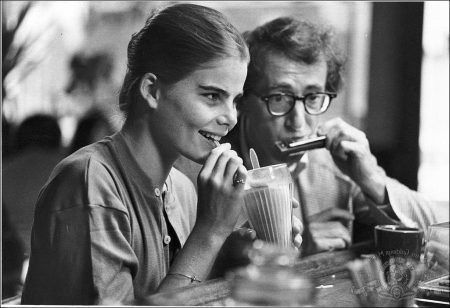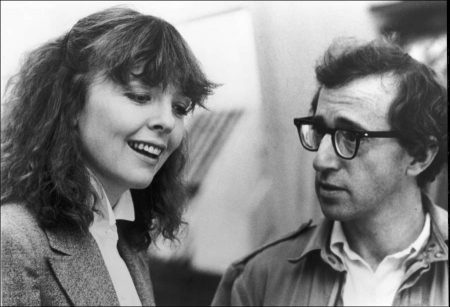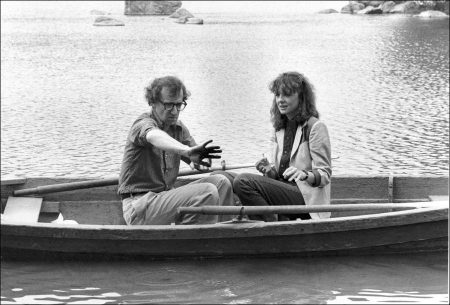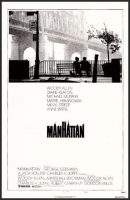Manhattan movie storyline. Isaac is a twice divorced New York writer with a 17 year-old girlfriend, Tracy, who has quit his job and is now afraid his upcoming book won’t provide him with much of an income. It doesn’t help that one of his ex-wives is also writing a book about their time together. He meets the somewhat pretentious Mary – who is seeing his married friend Yale – and he immediately takes a disliking to her.
As they meet again however they begin to take an interest in each other and eventually fall in love. Tracy has a scholarship to a school in Europe and Isaac encourages her to take it, saying there is no future for them given the differences in their ages and the fact that he loves Mary. When Mary rekindles her affair with Yale, Isaac is left in the middle.
Manhattan is a 1979 American romantic comedy film directed by Woody Allen and produced by Charles H. Joffe. The screenplay was written by Allen and Marshall Brickman. Allen co-stars as a twice-divorced 42-year-old comedy writer who dates a 17-year-old girl (Mariel Hemingway) but falls in love with his best friend (Michael Murphy)’s mistress (Diane Keaton). Meryl Streep and Anne Byrne also star.
Manhattan premiered at the Ziegfeld Theatre in New York City on April 18, 1979. It opened in 27 theaters in New York City, Los Angeles and Toronto on April 25, then expanded to an additional 256 theaters nationwide on May 4, before adding a further 117 screens a week later. The film was shown out of competition at the 1979 Cannes Film Festival in May.
The film grossed $485,734 ($16,749 per screen) in its opening weekend[19] and after expanding nationwide, it had grossed $3.5 million after 13 days. It grossed $39.9 million in its entire run in the United States and Canada, making the film the 17th highest-grossing picture of the year. Adjusted for ticket price inflation (as of 2017), Manhattan grossed $141,484,800, making it Allen’s second biggest box-office hit, following 1977’s Annie Hall.
About the Filming
Allen talked to cinematographer Gordon Willis about how fun it would be to shoot the film in black and white, Panavision aspect ratio (2.35:1) because it would give “a great look at New York City, which is sort of one of the characters in the film”. Allen decided to shoot his film in black and white because that was how he remembered it from when he was small. “Maybe it’s a reminiscence from old photographs, films, books and all that. But that’s how I remember New York.” He always heard Gershwin music with it, too. In Manhattan he really thinks that he and Willis succeeded in showing the city. “When seeing it there on that big screen, it’s really decadent”. The picture was shot on location with the exception of some of the scenes in the planetarium which were filmed on a set.
The famous bridge shot was done at five in the morning. The production had to bring their own bench as there were no park benches at the location. The bridge had two sets of necklace lights on a timer controlled by the city. When the sun came up, the bridge lights went off. Willis made arrangements with the city to leave the lights on and that he would let them know when they got the shot. Afterward, they could be turned off. As they started to shoot the scene, one string of bridge lights went out, and Allen was forced to use that take.
After finishing the film, Allen was very unhappy with it and asked United Artists not to release it. He offered to make a film for no fee instead. He later said, “I just thought to myself, ‘At this point in my life, if this is the best I can do, they shouldn’t give me money to make movies.'”
About the Music
All titles of the soundtrack were compositions by George Gershwin. They were performed by the New York Philharmonic under Zubin Mehta and the Buffalo Philharmonic under Michael Tilson Thomas. A part of the first movement of Mozart’s Symphony No. 40 is heard in a concert scene.
New York Philharmonic
“Rhapsody in Blue”
“Love is Sweeping the Country”
“Land of the Gay Caballero”
“Sweet and Low Down”
“I’ve Got a Crush on You”
“Do-Do-Do”
“‘S Wonderful”
“Oh, Lady Be Good!”
“Strike Up the Band”
“Embraceable You”
Buffalo Philharmonic
“Someone to Watch Over Me”
“He Loves and She Loves”
“But Not for Me”
Manhattan (1979)
Directed by: Woody Allen
Starring: Woody Allen, Diane Keaton, Michael Murphy, Mariel Hemingway, Meryl Streep, Anne Byrne, Michael O’Donoghue, Wallace Shawn, Karen Ludwig, Charles Levin, Karen Allen, David Rasche
Screenplay by: Woody Allen, Marshall Brickman
Production Design by: Mel Bourne
Cinematography by: Gordon Willis
Film Editing by: Susan E. Morse
Costume Design by: Albert Wolsky
Set Decoration by: Robert Drumheller
MPAA Rating: None.
Distributed by: United Artists
Release Date: April 25, 1979 (United States)
Views: 224



